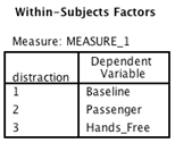An experiment was done to compare the effect of having a conversation via a hands-free mobile phone, having a conversation with an in-car passenger, and no distraction (baseline) on driving accuracy. Twenty participants from two different age groups (18-25 years and 26-40 years) took part. All participants in both age groups took part in all three conditions of the experiment (in counterbalanced order) , and their driving accuracy was measured by a layperson who remained unaware of the experimental hypothesis.
- Which of the following sentences regarding the results of the simple contrasts of the distraction variable is correct?


Definitions:
Person Power
The influence or capability derived from an individual's personal qualities or resources.
Informal Power
Influence that an individual possesses within a group or organization, not due to their official position, but through other means such as knowledge, personality, or relationships.
Qualities
Characteristics or attributes that are inherent or acquired by individuals, products, or entities.
Politicking Strategies
Methods or plans of action designed to manipulate or influence organizational processes or decisions for personal gain.
Q1: What are phi and Cramér's V used
Q2: A null hypothesis.<br>A) States that the experimental
Q4: If the distribution of CLV for your
Q5: Two samples of data are collected and
Q7: Which of the following sentences is correct?<br>A)The
Q9: Why are large samples desirable in statistical
Q14: What type of ANOVA is used when
Q15: Marvin Zuckerman's work on dimensions of sensation
Q22: A scatterplot shows<br>A) The frequency with which
Q23: If we calculated an effect size and